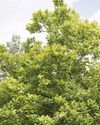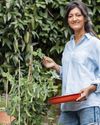
Pruning books and some websites can be incredibly daunting, full of jargon and complicated diagrams, which can put us off even getting our loppers out of the shed. Fear not, pruning is a lot more straightforward than you think and by following a few simple rules we can achieve much healthier shrubs. As sap rises through stems, plants can respond incredibly quickly to pruning by healing wounds and growing beyond those cuts.
Spring pruning encourages strong growth and is suited for plants that we grow for stem colour, foliage or those which flower in winter or later in the summer.Pruning tends to be more radical in spring because plants have a whole growing season to recover before the year is out.Waiting until March allows the worst of the winter weather to pass as this can damage the fragile young shoots that follow this style of pruning. Climate needs to be considered here, too: the warmer and more sheltered your garden, the earlier you can get the secateurs out; if you're in a frost pocket then it's best to wait a few more weeks.
Spring pruning can be divided into two groups: deciduous shrubs, which lose their leaves in winter, including winter-flowering shrubs; and evergreen and more tender shrubs, which should be pruned in late spring as they are still growing (albeit slowly) and whose young growth is more sensitive to a hard frost.
LOOK OUT FOR
Plant problems You can reduce spring aphid numbers while pruning
Early spring
Early spring is one of the most exciting times of the year. You can almost see the garden waking up. From early March to mid-April, we need to prune shrubs for stem colour and shrubs that flower in late summer and winter.Major rejuvenation pruning can take place too, including coppicing. Some grasses can also be cut back to make way for new shoots.
Late-summer flowering shrubs
This story is from the March 2022 edition of Gardeners World.
Start your 7-day Magzter GOLD free trial to access thousands of curated premium stories, and 9,000+ magazines and newspapers.
Already a subscriber ? Sign In
This story is from the March 2022 edition of Gardeners World.
Start your 7-day Magzter GOLD free trial to access thousands of curated premium stories, and 9,000+ magazines and newspapers.
Already a subscriber? Sign In

A new plot for tasty crops
Taking on a new allotment needn't be hard work. By simply following a few easy tips you can have bumper crops in no time, just like Alessandro Vitale

We love July
July is an island floating between the joy of June and the slightly fatigued month of August. It's a grown-up month: the year has shrugged off its adolescent exuberances, the weather is (hopefully) warm enough for ice cream to be one of your five a day, the sea should be swimmable without (too much) danger of hypothermia and thoughts will be of holiday shenanigans and family barbecues. School's out this month, the next tranche of glorious summer colour is washing across our borders and it's my birthday. Lots of reasons to give three rousing cheers for July!

YOUR PRUNING MONTH
Now, at the height of summer, Frances Tophill shows how to boost your plants' health and productivity with a timely cut

Hassle-free harvests
Flowers are out in abundance this month and for Jack Wallington, many of these blooms make delicious, low-effort pickings

Bite-sized bounties
Glorious doorstep harvests can easily turn into gluts, so let Rukmini Iyer's recipes help you savour every last bit

Upcycled outdoor living
Create unique and stylish garden features for minimal cost using reclaimed materials and simple DIY skills. Helen Riches shares four step-by-step projects and more inspiring eco tips

Secrets of a COLOURFUL GARDEN
Buildings and landscapes can play a vital role in supercharging your space, as Nick Bailey demonstrates

Greening up a city balcony
Looking for sustainable, small-space gardening ideas? Take inspiration from Oliver Hymans' transformed balcony garden in north-east London - now a lush, green haven for humans and wildlife

The dry and mighty garden
As we adapt our gardens to a more volatile climate, Alan Titchmarsh reveals how to create a drought-tolerant plot and picks his top plant performers

Nature knows best
Carol Klein explains how to choose plants for specific growing conditions, based on what has naturally adapted to thrive there